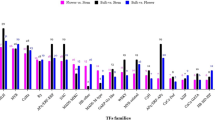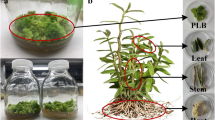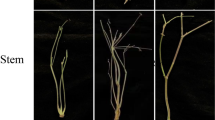Abstract
Watercress (Nasturtium officinale R. Br.) is a cruciferous plant consumed by people worldwide. This vegetable contains numerous health-benefiting compounds; however, gene information and metabolomic profiling of individual parts for this plant species are scarce. In this study, we investigated the expression patterns of phenylpropanoid biosynthetic genes and the content of phenylpropanoids in different parts of watercress. We identified 11 genes encoding enzymes related to the phenylpropanoid biosynthetic pathway and analyzed the expression patterns of these genes in the leaves, stems, roots, flowers, and seeds of watercress. The result showed that most of the genes were expressed at the highest levels in the flowers. HPLC analysis performed in samples from these same parts revealed the presence of seven phenylpropanoid-derived compounds. The content of total phenylpropanoids was the highest in flowers, followed by that in the leaves, whereas the lowest level was generally detected in the stems. Rutin was the most abundant phenylpropanoid in all plant segments, while quercetin was detected only in the flowers and roots. This study provides useful information for further molecular and functional research involving N. officinale and closely related species.


Similar content being viewed by others
References
Aires A, Carvalho R, Rosa EAS, Saavedra MJ (2013) Phytochemical characterization and antioxidant properties of baby-leaf watercress produced under organic production system. CyTA J Food 11:343–351
André CM, Schafleitner R, Legay S, Lefèvre I, Aliaga CAA, Nomberto G, Hoffmann L, Hausman JF, Larondelle Y, Evers D (2009) Gene expression changes related to the production of phenolic compounds in potato tubers grown under drought stress. Phytochem 70:1107–1116
Cruz R, Vieira MC, Silva CL (2006) Effect of heat and thermosonication treatments on peroxidase inactivation kinetics in watercress (Nasturtium officinale). J Food Eng 72:8–15
Cruz R, Vieira MC, Silva CL (2008) Effect of heat and thermosonication treatments on watercress (Nasturtium officinale) vitamin C degradation kinetics. Innov Food SciEmerg Technol 9:483–488
Feng C, Chen M, Xu CJ, Bai L, Yin XR, Li X, Allan AC, Ferguson IB, Chen KS (2012) Transcriptomic analysis of Chinese bayberry (Myricarubra) fruit development and ripening using RNA-Seq. BMC Genom 13:19
Fogelman E, Tanami S, Ginzberg I (2015) Anthocyanin synthesis in native and wound periderms of potato. Physiol Plant 153:616–626
Garg R, Patel RK, Tyagi AK, Jain M (2011) De novo assembly of chickpea transcriptome using short reads for gene discovery and marker identification. DNA Res 18:53–63
Gill CI, Haldar S, Boyd LA, Bennett R, Whiteford J, Butler M, Pearson JR, Bradbury I, Rowland IR (2007) Watercress supplementation in diet reduces lymphocyte DNA damage and alters blood antioxidant status in healthy adults. Am J Clin Nutr 85:504–510
Gonçalves E, Cruz R, Abreu M, Brandão T, Silva CL (2009) Biochemical and colour changes of watercress (Nasturtium officinale R. Br.) during freezing and frozen storage. J Food Eng 93:32–39
Im AR, Kim YH, Uddin MR, Chae SW, Lee HW, Kim YS, Lee MY (2013) Neuroprotective effects of Lyciumchinense Miller extracts against the neurotoxicity induced by rotenone. Am J Chin Med 41:1343–1359
Jeon J, Bong SJ, Park JS, Park YK, Arasu MV, Al-Dhabi NA, Park SU (2017) De novo transcriptome analysis and glucosinolate profiling in watercress (Nasturtium officinale R. Br.). BMC Genom 18:401
Kim YJ, Kim YB, Li X, Choi SR, Park S, Park JS, Lim YP, Park SU (2015) Accumulation of phenylpropanoids by white, blue, and red light irradiation and their organ-specific distribution in Chinese cabbage (Brassica rapa ssp. pekinensis). J Agric Food Chem 63:6772–6778
Koes RE, Quattrocchio F, Mol JN (1994) The flavonoid biosynthetic pathway in plants: function and evolution. BioEssays 16:123–132
Langmead B, Salzberg SL (2012) Fast gapped-read alignment with Bowtie 2. Nat Methods 9:357–359
Li X, Park NI, Xu H, Woo SH, Park CH, Park SU (2010) Differential expression of flavonoid biosynthesis genes and accumulation of phenolic compounds in common buckwheat (Fagopyrumesculentum). J Agric Food Chem 58:12176–12181
Martens S, Preuss A, Matern U (2010) Multifunctional flavonoid dioxygenases: flavonol and anthocyanin biosynthesis in Arabidopsis thaliana L. Phytochem 71:1040–1049
Martinez-Sanchez A, Gil-Izquierdo A, Gil MI, Ferreres FA (2008) Comparative study of flavonoid compounds, vitamin C, and antioxidant properties of baby leaf Brassicaceae species. J Agric Food Chem 56:2330–2340
Ozen T (2009) Investigation of antioxidant properties of Nasturtium officinale (watercress) leaf extracts. Acta Pol Pharm 66:187–193
Park CH, Yeo HJ, Park YE, Chun SW, Chung YS, Lee SY (2019) Park SU (2019) Influence of chitosan, salicylic acid and jasmonic acid on phenylpropanoid accumulation in germinated buckwheat (Fagopyrum esculentum Moench). Foods 8:153
Podsędek A (2007) Natural antioxidants and antioxidant capacity of Brassica vegetables: a review. LWT Food Sci Technol 40:1–11
Pourhassan-Moghaddam M, Zarghami N, Mohsenifar A, Rahmati-Yamchi M, Gholizadeh D, Akbarzadeh A, De La Guardia M, Nejati-Koshki K (2014) Watercress-based gold nanoparticles: biosynthesis, mechanism of formation and study of their biocompatibility in vitro. Micro Nano Lett 9:345–350
Roberts A, Pachter L (2013) Streaming fragment assignment for real-time analysis of sequencing experiments. Nat Methods 10:71–73
Sadeghi H, Mostafazadeh M, Sadeghi H, Naderian M, Barmak MJ, Talebianpoor MS, Mehraban F (2014) In vivo anti-inflammatory properties of aerial parts of Nasturtium officinale. Pharm Biol 52:169–174
Shapiro TA, Fahey JW, Wade KL, Stephenson KK, Talalay P (2001) Chemoprotectiveglucosinolates and isothiocyanates of broccoli sprouts: metabolism and excretion in humans. Cancer Epidemiol Biomarkers Prev 10:501–508
Shi CY, Yang H, Wei CL, Yu O, Zhang ZZ, Jiang CJ, Sun J, Li YY, Chen Q, Xia T, Wan XC (2011) Deep sequencing of the Camellia sinensis transcriptome revealed candidate genes for major metabolic pathways of tea-specific compounds. BMC Genom 12:131
Voutsina N, Payne AC, Hancock RD, Clarkson GJ, Rothwell SD, Chapman MA, Taylor G (2016) Characterization of the watercress (Nasturtium officinale R. Br.; Brassicaceae) transcriptome using RNASeq and identification of candidate genes for important phytonutrient traits linked to human health. BMC Genom 17:378
Acknowledgements
This work was supported by the funds from the Incheon National University Research grant in 2018.
Author information
Authors and Affiliations
Contributions
Conception and design of the experiments: J.K Kim and S.U. Park. Performed the experiments and analyzed the data: S.J. Bong, J. Jeon, and Y.J. Park. Wrote the manuscript: S.J. Bong, J. Jeon, and S.U. Park. All authors read and approved the final manuscript.
Corresponding authors
Ethics declarations
Conflict of interest
The authors declare that they have no conflict of interest.
Ethical approval
This article does not contain any original research involving human participants or animals.
Electronic supplementary material
Below is the link to the electronic supplementary material.
Rights and permissions
About this article
Cite this article
Bong, S.J., Jeon, J., Park, Y.J. et al. Identification and analysis of phenylpropanoid biosynthetic genes and phenylpropanoid accumulation in watercress (Nasturtium officinale R. Br.). 3 Biotech 10, 260 (2020). https://doi.org/10.1007/s13205-020-02244-y
Received:
Accepted:
Published:
DOI: https://doi.org/10.1007/s13205-020-02244-y




